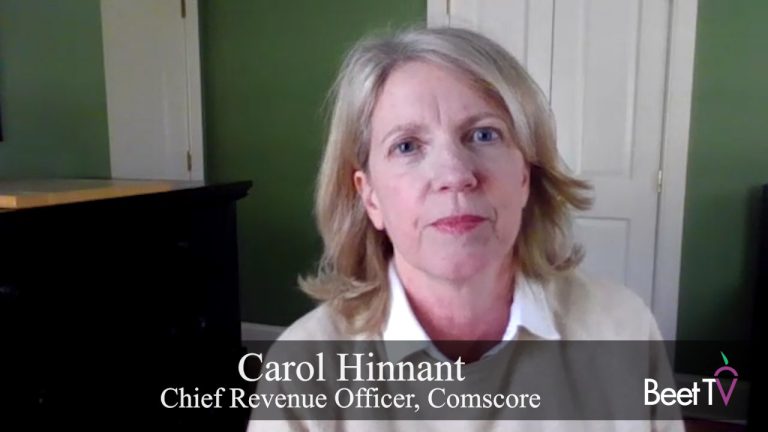
If a tree falls in a forest, but two observers disagree on what exactly happened, did it really make a sound?
That is the key question which has suddenly engulfed the craft of TV measurement, as Nielsen’s admission it may not have measured pandemic TV audiences as well as beforehand has caused TV execs to worry audiences may be as much as 10% under-reported.
Amid the kerfuffle, rival Comscore senses an opportunity.
In this video interview with Beet.TV, Comscore’s chief revenue officer Carol Hinnant says a new deal inked with ViacomCBS shows TV networks are coming to value the approach of panel-informed measurement over panel-dependent measurement.
Measurement debate
As their ratings drop, TV networks fault Nielsen. Media researchers weigh in https://t.co/IKPhO22Z5N pic.twitter.com/h9P9RP5sAJ
— Forbes (@Forbes) April 21, 2021
“The controversy in the marketplace today is that, on a panel-based approach you’re dealing with a small sample, and you’re having to project that to the viewing behaviours,” Hinnant says.
“I think that given the sample, and the ability to recruit during the pandemic it’s caused a lot of controversy. I think that the pandemic has certainly emphasised to the marketplace the value of (TV) return-path data.
“What Comscore does, which is very different, is that we have secured return-path (viewing) data from set-top boxes for wired households, and we ingest that data. It’s our ‘massive and passive’ form of measurement that really is propelling the industry to look at Comscore as a currency.
“One in three television households in the US are contributing passive measurement. We are not asking for participation, and we’re not looking for button-pushing, we are collecting that data in a passive way, and that’s a very different approach than the panel-based approach.”
ViacomCBS extends
To prove her point, Hinnant points to news this week in which ViacomCBS an expanded renewal agreement to use Comscore’s national TV measurement currency for its news, entertainment and sports networks, enabling ViacomCBS to guarantee its traditional linear advertising campaigns.
“It’s the first time that a major media company has actually come out and said now they have currency diversity,” Hinannt says.
“There’s a choice in television measurement, and it’s not just Nielsen anymore, and Comscore is playing a huge role in that.
“The announcement here is really about Comscore reaching parity with Nielsen in terms of television measurement.”
Counting views
During the pandemic, the widespread assumption was that television viewing boomed as stay-at-home consumers swelled consumption.
That is why TV networks, flanked by their Video Advertising Bureau (VAB) representative body, recently criticized Nielsen for reporting a decline in viewing and usage during the 2020 period.
VAB complained that the number of households providing usable data to its people meter between February 2020 and February 2021 fell considerably, leading to an under-counting of true TV viewing.
Nielsen says it will continue to be scrutinized by the Media Ratings Council (MRC) but not by auditor Ernst & Young as requested by VAB.
The apparent under-measurement dropped a problem onto TV networks’ laps as they went into a critical upfront ad sales season. Concerned TV networks are now seen as exploring additional solutions.
Measurement methods
Comscore has seized on the debate.
In a blog post and lengthy analysis, it says “small samples today are extremely unstable”:
“The dynamics of panel refusal have almost certainly changed during the COVID-19 pandemic, particularly when empanelment requires in-home interviews or installation.
“Thus, even if there may have been some attempt to understand the effect of nonparticipation bias before 2020, in the pandemic and post-pandemic worlds those conclusions, particularly for methods that include in-home visits, are now largely inapplicable.”
Nate made fun of me b/c I got excited about getting the Nielsen rating survey we got ? tru TV fans will kno ?? pic.twitter.com/PXJFdV15GN
— Candi(ce) ? (@notmaeby) April 20, 2021
we’re informed by panels